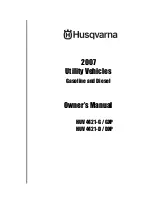
143
1. Connect the meter leads (selector in OHMS position)
to the sensor terminals.
2. Suspend the sensor and a thermometer in a container
of cooking oil; then heat the oil.
NOTE: Neither the sensor nor the thermometer
should be allowed to touch the bottom of the con-
tainer or inaccurate readings will occur. Use wire
holders to suspend the sensor and thermometer.
3. If the readings are not as indicated, the sensor must
be replaced.
4. Install the sensor and tighten securely; then connect
the leads.
SPEED SENSOR
NOTE: Prior to testing the speed sensor, inspect the
three-wire connector on the speed sensor for contami-
nation, broken pins, and/or corrosion.
1. Set the meter selector to the DC Voltage position.
2. With appropriate needle adapters on the meter leads,
connect the red tester lead to the orange wire; then
connect the black tester lead to the black wire.
3. Turn the ignition switch to the ON position.
4. The meter will typically show battery voltage.
5. Leave the black tester lead connected; then connect
the red tester lead to the pink/white wire.
6. Slowly move the vehicle forward or backward; the
meter must show 0 and battery voltage alternately.
To replace a speed sensor, use the following procedure.
1. Disconnect the three-wire connector from the speed
sensor; then remove the cap screw securing the sen-
sor to the sensor housing.
2. Remove the sensor from the sensor housing account-
ing for an O-ring.
3. Install the new speed sensor into the housing with
new O-ring lightly coated with multi-purpose grease;
then secure the sensor with the cap screw (threads
coated with blue Loctite #242). Tighten securely.
CD071
FUEL PUMP/FUEL LEVEL SENSOR
The fuel pump and fuel level sensor are not serviceable
components. If either component fails, it must be
replaced.
Testing
1. Turn the ignition switch ON and listen for a momen-
tary “whirring” sound of the pump building pressure.
If the sound is heard (several seconds), no electrical
checks are necessary. Turn the ignition switch OFF.
2. Disconnect the gasline hose from the fuel rail; then
install a suitable pressure gauge.
FI092A
3. Reconnect the fuel pump electrical connector; then
turn the ignition switch to the ON position. The fuel
pressure should build until the pump shuts off. Pres-
sure should read 3.0 kg-cm
2
(43 psi).
! WARNING
Wear insulated gloves and safety glasses. Heated oil
can cause severe burns.
MODEL
OIL TEMPERATURE
OHMS
500
60 °C (140 °F)
704k
90 °C (194 °F)
261
120 °C (248 °F)
111
700
-20 °C (-4 °F)
19k
40 °C (105 °F)
1.13k
100 °C (212 °F)
0.15
! WARNING
Whenever any maintenance or inspection is made on
the fuel system during which there may be fuel leakage,
there should be no welding, smoking, open flames, etc.,
in the area.
AT THIS POINT
Prior to removing the electric fuel pump, the following
check should be performed to determine that removal is
necessary.
! WARNING
Gasoline may be under pressure. Depressurize the fuel
system by disconnecting the fuel pump electrical con-
nector and running the engine until it stalls. Place an
absorbent towel around the connector to absorb any
gasoline when disconnecting.
Summary of Contents for HDX 500 2017
Page 1: ...2017 S SERVICE ERVICE MANUAL ANUAL www arcticcat com ...
Page 188: ...187 NOTES ...
Page 189: ...188 NOTES ...
















































